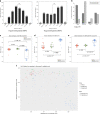Clinically and biologically relevant subgroups of Wilms tumour defined by genomic and epigenomic analyses
- PMID: 33012783
- PMCID: PMC7853092
- DOI: 10.1038/s41416-020-01102-1
Clinically and biologically relevant subgroups of Wilms tumour defined by genomic and epigenomic analyses
Abstract
Background: Although cure rates for Wilms tumours (WT) are high, many patients receive therapy with attendant long-term complications. Our goal was to stratify WT using genome-wide analyses to identify candidate molecular features for patients who would benefit from a reduction in therapy.
Methods: We generated DNA methylation and exome sequencing data on WT-kidney pairs (n = 57) and unpaired tumours (n = 27) collected either at our centre or by the Children's Oncology Group. Samples were divided into a discovery set (n = 32) and validation set (n = 52).
Results: Analysis of DNA methylation revealed two subgroups of WT with distinct features. Subgroup A has a similar DNA methylation profile to mature kidney, while Subgroup B has genome-wide dysregulation of DNA methylation. The rate of non-synonymous missense mutations and segmental chromosomal aberrations was higher in Subgroup B tumours, suggesting that this group has genome instability related to its epigenetic state. Subgroup A had a higher proportion of cases of bilateral disease. Tumours with high-risk histology or from patients who relapsed were only found in Subgroup B.
Conclusion: We have identified subgroup-specific molecular events that could inform future work supporting more targeted therapeutic approaches and patient stratification. We propose a novel developmental tumour model based on these findings.
Conflict of interest statement
The authors declare no competing interests.
Figures




Similar articles
-
Allelic loss on chromosome 11p is a less frequent event in bilateral than in unilateral Wilms' tumours.Eur J Cancer. 1992;28A(11):1876-80. doi: 10.1016/0959-8049(92)90027-y. Eur J Cancer. 1992. PMID: 1356388
-
Clinically relevant subsets identified by gene expression patterns support a revised ontogenic model of Wilms tumor: a Children's Oncology Group Study.Neoplasia. 2012 Aug;14(8):742-56. doi: 10.1593/neo.12714. Neoplasia. 2012. PMID: 22952427 Free PMC article.
-
Wilms tumour histology is determined by distinct types of precursor lesions and not epigenetic changes.J Pathol. 2008 Aug;215(4):377-87. doi: 10.1002/path.2366. J Pathol. 2008. PMID: 18484682
-
Wilms' tumour: a complex enigma to decipher.Clin Transl Oncol. 2008 Aug;10(8):457-61. doi: 10.1007/s12094-008-0233-6. Clin Transl Oncol. 2008. PMID: 18667375 Review.
-
Origins of DNA methylation defects in Wilms tumors.Cancer Lett. 2019 Aug 10;457:119-128. doi: 10.1016/j.canlet.2019.05.013. Epub 2019 May 16. Cancer Lett. 2019. PMID: 31103718 Review.
Cited by
-
DNA methylation signature associated with Bohring-Opitz syndrome: a new tool for functional classification of variants in ASXL genes.Eur J Hum Genet. 2022 Jun;30(6):695-702. doi: 10.1038/s41431-022-01083-0. Epub 2022 Apr 1. Eur J Hum Genet. 2022. PMID: 35361921 Free PMC article.
-
TRIM28 variants and Wilms' tumour predisposition.J Pathol. 2021 Jul;254(4):494-504. doi: 10.1002/path.5639. Epub 2021 Mar 15. J Pathol. 2021. PMID: 33565090 Free PMC article. Review.
-
Genetic and epigenetic features of bilateral Wilms tumor predisposition in patients from the Children's Oncology Group AREN18B5-Q.Nat Commun. 2023 Dec 18;14(1):8006. doi: 10.1038/s41467-023-43730-0. Nat Commun. 2023. PMID: 38110397 Free PMC article.
-
Comment on "Outcomes of robotic-assisted surgery for pediatric renal tumors: a systematic review".J Robot Surg. 2025 Jul 7;19(1):359. doi: 10.1007/s11701-025-02530-y. J Robot Surg. 2025. PMID: 40622645 No abstract available.
-
Hallmark discoveries in the biology of Wilms tumour.Nat Rev Urol. 2024 Mar;21(3):158-180. doi: 10.1038/s41585-023-00824-0. Epub 2023 Oct 17. Nat Rev Urol. 2024. PMID: 37848532 Review.
References
-
- Chagtai T, Zill C, Dainese L, Wegert J, Savola S, Popov S, et al. Gain of 1q as a prognostic biomarker in Wilms tumors (WTs) treated with preoperative chemotherapy in the International Society of Paediatric Oncology (SIOP) WT 2001 Trial: a SIOP Renal Tumours Biology Consortium Study. J. Clin. Oncol. 2016;34:3195–3203. doi: 10.1200/JCO.2015.66.0001. - DOI - PMC - PubMed
-
- Fernandez CV, Perlman EJ, Mullen EA, Chi Y-Y, Hamilton TE, Gow KW, et al. Clinical outcome and biological predictors of relapse after nephrectomy only for very low-risk Wilms tumor: a report from Children’s Oncology Group AREN0532. Ann. Surg. 2016;265:835–840. doi: 10.1097/SLA.0000000000001716. - DOI - PMC - PubMed
Publication types
MeSH terms
Grants and funding
LinkOut - more resources
Full Text Sources
Medical

